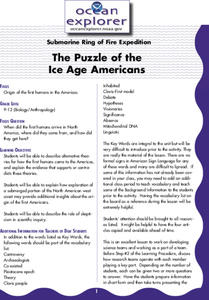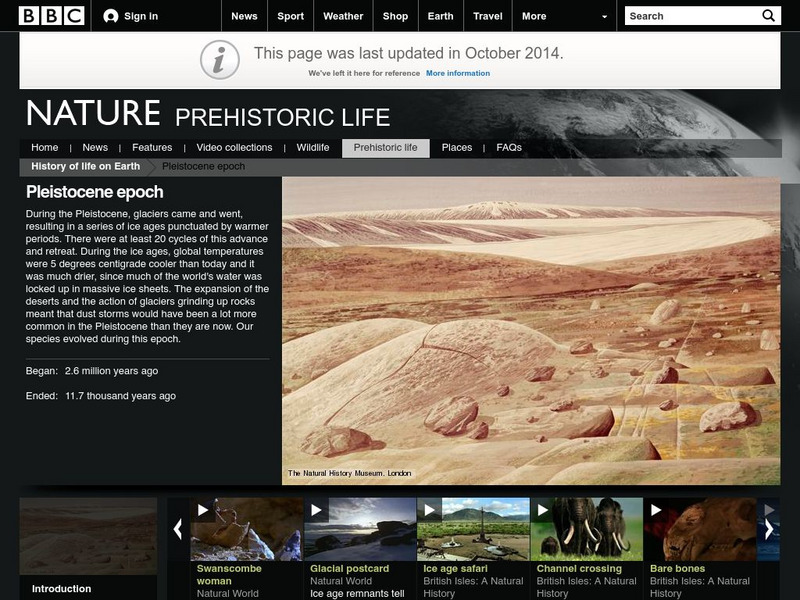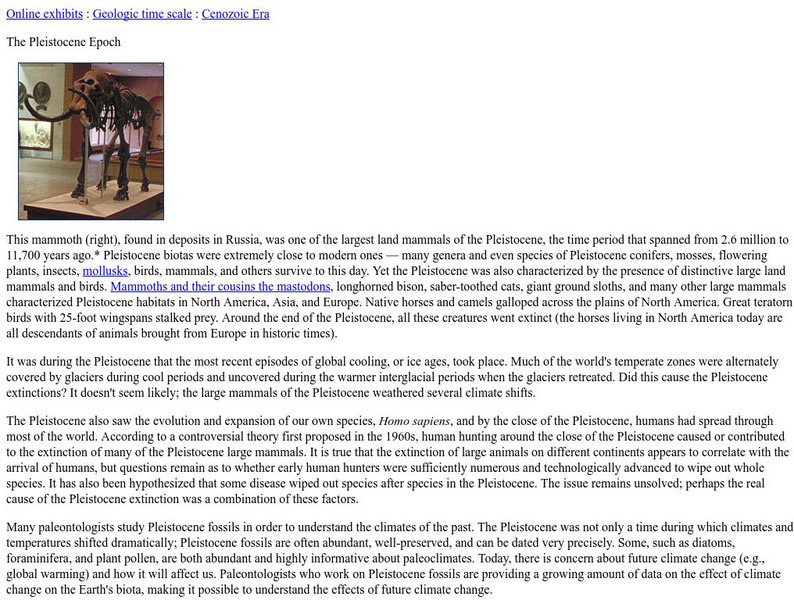Curated OER
The Puzzle of the Ice Age Americans
Students describe alternative theories for how the first humans came to the Americas, and explain evidence that supports or contradicts these theories. They examine the role of skepticism in scientific inquiries.
Encyclopedia of Earth
Encyclopedia of Earth: Evolutionary Biology: Pleistocene
Article describing the Pleistocene Epoch, which lasted from 1.8 million to about 10,000 years ago. It discusses species that lived then (e.g., the mammoth), and the climate changes that took place at that time. (Published: May 8, 2010)
Other
Illinois State Museum: The Midwestern United States 16,000 Years Ago
What did Northern America look like 16,000 years ago? Were the plants the same? What happened to the mastodons and the saber-toothed cats? Here's a short website that is easy-to-understand and supplies at least some of the answers.
BBC
Bbc Nature: Prehistoric Life: Pleistocene Epoch
Overview of the Earth in the Pleistocene Epoch told by photos, news, and external links with an emphasis on what grew then, what lived then, the causes of mass extinction, types of fossils, and what life was like in general.
PBS
Nova: America's Stone Age Explorers: End of the Big Beasts
Three opposing views about the disappearance of the "megafauna" in North America. What really happened to the wooly mammoth, mastadon, saber-toothed tiger, among other animals?
University of California
Ucmp: The Pleistocene
The UCMP Berkeley provides a brief overview of the Pleistocene Era, including links to more information.
University of California
Ucmp: The Case of the Irish Elk
This site provides a general overview of the extinct deer species, the Irish Elk.
San Diego Natural History Museum
San Diego Natural History Museum: Fossil Field Guide: Dire Wolf
A look at what fossil evidence reveals about life and ecological interactions of the extinct dire wolf.
San Diego Natural History Museum
San Diego Natural History Museum: Fossil Field Guide: Mammoth
A look at what fossil evidence reveals about the life and ecological interactions of the extinct mammoth.
San Diego Natural History Museum
San Diego Natural History Musem: Fossil Field Guide: Giant Ground Sloth
A look at what fossil evidence tells us about the life and ecology of prehistoric giant ground sloths.
San Diego Natural History Museum
San Diego Natural History Museum: Fossil Field Guide: American Lion
A brief look at what fossil evidence reveals about the life and feeding habits of prehistoric American lions.
San Diego Natural History Museum
San Diego Natural History Museum: Fossil Field Guide: American Mastodon
A detailed look at what fossil evidence unveils about the life and ecological interactions of the extinct American mastodon.
Bagheera
Bagheera.com: Extinct in the Wild Pleistocene Mammoth and Sabertooth Cat
This article is about the many mammals that became extinct in the late Pleistocene era. Many causes are considered and there are some great questions at the end for your consideration.
Canadian Museum of Nature
Canadian Museum of Nature: Saiga
The Canadian Museum of Nature describes the Saiga-an adaptable and speedy Prehistoric Mammal.
Other
Denver Museum of Nature and Science: Ice Age Giants Coloring Pages [Pdf]
Printable coloring sheets of Ice Age animals, such as the dire wolf, the giant beaver, the American mastodon, and the saber-toothed cat.
















![Denver Museum of Nature and Science: Ice Age Giants Coloring Pages [Pdf] Activity Denver Museum of Nature and Science: Ice Age Giants Coloring Pages [Pdf] Activity](https://d15y2dacu3jp90.cloudfront.net/images/attachment_defaults/resource/large/FPO-knovation.png)